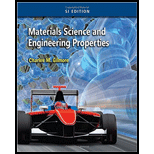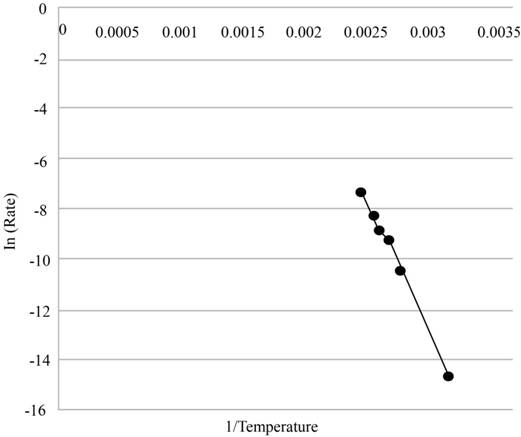
Concept explainers
(a)
The plot of the logarithm of the rate of recrystallization versus the inverse of the absolute temperature and to check whether it is linear or not.
Answer to Problem 4.19P
The graph of logarithm of the rate of recrystallization versus the inverse of absolute temperature is shown in figure (1) and it is linear.
Explanation of Solution
Given:
The given table is,
| S. No. | Temperature |
Time (Seconds) |
| |
|
|
| |
|
|
| |
|
|
| |
|
|
| |
392 | |
| |
|
|
Calculation:
Draw the table to plot the graph of logarithm of the rate of recrystallization versus the inverse of absolute temperature.
| S. No. | Temperature |
|
Time
|
Rate
|
|
| |
|
|
|
|
|
| |
|
|
|
|
|
| |
|
|
|
|
|
| |
|
|
|
|
|
| |
392 | |
|
|
|
| |
|
|
|
|
|
The graph of logarithm of the rate of recrystallization versus the inverse of absolute temperature is shown below.

Figure (1)
Conclusion:
Therefore, the graph of logarithm of the rate of recrystallization versus the inverse of absolute temperature is shown in figure (1) and it is linear.
(b)
The activation enthalpy for the recrystallization of copper.
Answer to Problem 4.19P
The activation enthalpy for the recrystallization of copper is
Explanation of Solution
Formula Used,
The activation enthalpy for the recrystallization of copper is given by,
Here,
Calculation:
The activation enthalpy for the recrystallization of copper is calculated as,
Substitute
Conclusion:
Therefore, the activation enthalpy for the recrystallization of copper is
(c)
The reason for activation enthalpy of recrystallization of copper being less than the activation enthalpy for vacancy diffusion.
Answer to Problem 4.19P
The activation enthalpy for the recrystallization is less than the activation enthalpy for vacancy diffusion because during the process of recrystallization, the size of grains increases and the vacancy site decreases.
Explanation of Solution
Introduction:
The Gibbs free energy is the energy that is available or free, to do work under conditions of constant pressure and temperature.
The expression for the Gibb’s free energy is given by,
Here,
The term
Here,
During the process of recrystallization, the size of the grain changes to form a new crystal structure. By this process the grain size changes its size by diffusing into other grains, thereby increasing the size of the grains. When the size of the grain increases, the possibility for the vacancy site decreases; that’s why the activation enthalpy of recrystallization of copper is less than the activation enthalpy for vacancy diffusion.
Conclusion:
Therefore, the activation enthalpy for the recrystallization is less than the activation enthalpy for vacancy diffusion because during the process of recrystallization, the size of grains increases and the vacancy site decreases.
(d)
The temperature at which the copper completely crystallizes in
Answer to Problem 4.19P
The temperature at which the copper completely crystallizes in
Explanation of Solution
Formula Used,
The logarithmic rate of crystallization is given by,
Here,
Calculation:
The logarithmic rate of crystallization is calculated as,
Substitute
Drop a perpendicular from
Conclusion:
Therefore, the temperature at which the copper completely crystallizes in
Want to see more full solutions like this?
Chapter 4 Solutions
Materials Science and Engineering Properties, SI Edition
- The factor of safety for tipping of the concrete dam is defined as the ratio of the stabilizing moment due to the dam's weight divided by the overturning moment about OO due to the water pressure (Figure 1). Suppose that aa = 5 mm , dd = 2 mm , hh = 7 mm . The concrete has a density of ρconcρconc = 2.5 Mg/m3Mg/m3 and for water ρwρw = 1 Mg/m3Mg/m3arrow_forwardcan you answer both plss, i will give u a likearrow_forward*1-4. The hollow core panel is made from plain stone concrete. Determine the dead weight of the panel. The holes each have a diameter of 100 mm. 200 mm 300 mm 300 mm 300 mm 300 mm 300 mm Prob. 1-4 300 mm 4 marrow_forward
- derive the expressions for V and M, and draw the shear forceandbendingmomentdiagrams.Neglecttheweightofthebeam.arrow_forwarda. Draw trajectories of approximately 8 to 11 vehicles moving on a one way 1-lane road with different time-varying speeds. b. Consider a time-space window in the time-space diagram of part (a). See below. Denote the number of vehicles passing BD, DC, AC, and AB respectively as n1, N2, N3, and n4. Write an equation relating n₁, N2, N3, and n4 to each other. What is the physical intuition of this equation? Please elaborate. X 4 X. n4 n3 с n2 X1 D B n1 t c. Using density (k) definition at time instances t₁ and t₂ and flow (q) definition at locations X1 and X2, rewrite equation of interest in part (b) to demonstrate KAB-KCD 9BD-9AC + t₂-t1 x2-x1 = 0. d. What will be the equation in part (c), in case of x2 → x1 and t₂ → t₁.arrow_forwardConsider a city center where the traffic conditions are described by a Macroscopic Fundamental Diagram (MFD) of network outflow (g- rate of trips finished) vs. accumulation (n- number of cars) with a trapezoidal shape, as shown in the figure below. The values of the parameters are: • • maximum trip completion rate gmax=100 [veh/min] critical accumulations ncr1=1000 [veh] and ncr2=1500 [veh] jam accumulation njam=4000 [veh]. gmax ncr1 ncr2 njam There are two types of demands in the morning peak hour (7-8am): trips generated from outside the city center with rate q1=80 [veh/min], and trips generated from within the city center with rate q2=50 [veh/min]. In addition, a perimeter traffic control, u, is available that only restricts vehicles entering the city from outside. If at 7am there are already no=500 [veh] in the city center: a. Write the dynamic equations (mass conservation equation) in a continuous form for the center of the city. b. Convert the continuous dynamic into the discrete…arrow_forward
- Assume a car park facility where the arrival rate is 1 customer every minute, and the service process including pressing the button, taking the card, and waiting for the boom to rise leads to service rate of μ customer every minute. a. Assume the arrival and service processes are stochastic. Using any software (Excel, Matlab, or the one you prefer), plot average delay time (including service time) and average queue size (including the vehicle currently being served) for all combinations of λ = {1,2,3,..,10} and p = {0.1,0.3,0.5,0.7,0.9}. Specifically, we ask you to make 2 graphs (one for average delay and the other for average queue size), where the x-axes contains the different values for 1, and where you make one curve for each p. b. Assume the arrival process is stochastic but the service process is deterministic with rate μ. Using any software (Excel, Matlab, or the one you prefer), plot average delay time (including service time) and average queue size (including the vehicle…arrow_forwardA traffic signal has a 60-second cycle length (Red time + Green time). For the travel direction of interest, the red and green times are 30 seconds each, the arrival rate is constant at 20 [veh/min] and the saturation flow (i.e., the departure rate) is 1 [veh/sec]. a. Calculate the average delay (for all vehicles) for the travel direction of interest. b. Assume a work zone on the street downstream of the intersection so that only 25 [veh/min] (in the direction of interest) can pass. Calculate the average delay caused by the work zone to a vehicle leaving the intersection. Assume that the queue at the work zone never backs- up into the intersection. c. Discuss qualitatively the implications of queue spillback from the work zone on the delay of the system. Traffic Direction (a) Traffic Direction (b)arrow_forwardAttached pics is a sample problem, can you compute it for me, I just want to compare my answer. Thank you.arrow_forward
- Problem 2: The Douglas fir beam below supports uniform live (WL) and dead loads (WD) as shown below. Assume the total distributed load is 700 lb/ft. WD=300#/PT. W₁ = 400# W₁ = 400#/FT- J J J J I J J J L=161 a) Assuming an alllowable deflection of L/360, compute the magnitude of the allowable deflection. b) Using an 8"x12" timber beam (see Table A1-b on page 567 of your text for properties) compute the actual deflection. Assume E = 1.6 x 100 psi. c) Based on your answers for parts a and b, determine if an 8"x12" timber beam is safe for this applicationarrow_forwardPlease use relationship method as I do not understand that one.arrow_forwardA freeway study resulted in a speed-density relationship: v=60(1-0.008k). Determine: a. The free-flow speed. b. The jam density. c. The speed-flow relationship. d. The flow-density relationship. e. The critical density. f. The capacity.arrow_forward
 Materials Science And Engineering PropertiesCivil EngineeringISBN:9781111988609Author:Charles GilmorePublisher:Cengage Learning
Materials Science And Engineering PropertiesCivil EngineeringISBN:9781111988609Author:Charles GilmorePublisher:Cengage Learning
